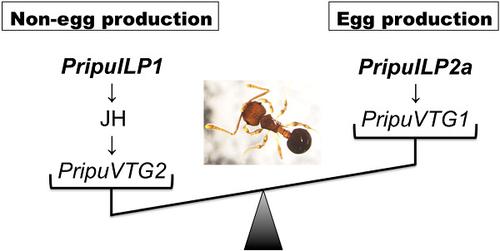当前位置:
X-MOL 学术
›
J. Exp. Zool. B Mol. Dev. Evol.
›
论文详情
Our official English website, www.x-mol.net, welcomes your
feedback! (Note: you will need to create a separate account there.)
Two insulin-like peptides may regulate egg production in opposite directions via juvenile hormone signaling in the queenless ant Pristomyrmex punctatus.
Journal of Experimental Zoology-B: Molecular and Developmental Evolution ( IF 1.8 ) Pub Date : 2020-02-10 , DOI: 10.1002/jez.b.22935 Marina Araki 1 , Misato O Miyakawa 1 , Tomohiro Suzuki 1 , Hitoshi Miyakawa 1
Journal of Experimental Zoology-B: Molecular and Developmental Evolution ( IF 1.8 ) Pub Date : 2020-02-10 , DOI: 10.1002/jez.b.22935 Marina Araki 1 , Misato O Miyakawa 1 , Tomohiro Suzuki 1 , Hitoshi Miyakawa 1
Affiliation

|
In the major eusocial species of Hymenoptera, the regulatory mechanisms controlling queen/worker differentiation and exclusive reproduction by queens have been studied extensively. These studies have shown that insulin/insulin-like growth factors and juvenile hormones (JHs) act as key endocrine factors. However, although considerable knowledge has accumulated in this area, large disparities in the regulatory mechanisms governing caste differentiation have been observed in different hymenopteran taxa to date. We focused on the queenless ant Pristomyrmex punctatus (Hymenoptera: Formicidae), which exhibits the simplest type of sociality and in which reproductive tasks (egg production) are distributed among morphologically and genetically identical workers. To elucidate the molecular mechanisms underlying reproduction in P. punctatus, we analyzed the correlations between the gene expression profiles of a reproductive marker gene, vitellogenin (PripuVTG1), and candidate regulatory genes comprising the major components of the JH and insulin/insulin-like growth factor signaling pathways that are involved in the regulation of reproduction upstream of JH signaling. Expression of insulin-like peptide 1 (PripuILP1) and JH signaling-related genes was negatively correlated with PripuVTG1 expression. On the contrary, insulin-like peptide 2 (PripuILP2a) was positively correlated with PripuVTG1. These findings suggest that an equilibrium perhaps controlled by switches in JH signaling exists between these two ILP paralogs, and that these interactions are important for regulating reproduction. Our findings are expected to be useful for understanding how various modes of sociality have evolved in insects.
中文翻译:

两种胰岛素样肽可通过无蚁后蚂蚁Pristomyrmex punctatus中的少年激素信号传导,以相反的方向调节卵的产生。
在膜翅目的主要共生物种中,控制女王/工人分化和女王独占繁殖的调控机制已得到广泛研究。这些研究表明,胰岛素/类胰岛素生长因子和少年激素(JHs)是关键的内分泌因子。然而,尽管在这一领域积累了相当多的知识,但迄今为止,在不同的膜翅类生物群中,在种姓分化的调控机制中仍存在巨大差异。我们集中研究了无蚁后蚂蚁Pristomyrmex punctatus(膜翅目:蚁科),它表现出最简单的社会类型,并且在形态和基因上相同的工人中分布着生殖任务(卵的生产)。为了阐明马尾松繁殖的分子机制,我们分析了生殖标志物基因,卵黄蛋白原(PripuVTG1)和候选调控基因的基因表达谱之间的相关性,这些调控基因包括JH和胰岛素/胰岛素样生长因子信号通路的主要成分,参与上游调控生殖JH信令。胰岛素样肽1(PripuILP1)和JH信号相关基因的表达与PripuVTG1表达负相关。相反,胰岛素样肽2(PripuILP2a)与PripuVTG1正相关。这些发现表明在这两个ILP旁系同源物之间可能存在由JH信号转导控制的平衡,并且这些相互作用对于调节繁殖很重要。
更新日期:2020-02-10
中文翻译:

两种胰岛素样肽可通过无蚁后蚂蚁Pristomyrmex punctatus中的少年激素信号传导,以相反的方向调节卵的产生。
在膜翅目的主要共生物种中,控制女王/工人分化和女王独占繁殖的调控机制已得到广泛研究。这些研究表明,胰岛素/类胰岛素生长因子和少年激素(JHs)是关键的内分泌因子。然而,尽管在这一领域积累了相当多的知识,但迄今为止,在不同的膜翅类生物群中,在种姓分化的调控机制中仍存在巨大差异。我们集中研究了无蚁后蚂蚁Pristomyrmex punctatus(膜翅目:蚁科),它表现出最简单的社会类型,并且在形态和基因上相同的工人中分布着生殖任务(卵的生产)。为了阐明马尾松繁殖的分子机制,我们分析了生殖标志物基因,卵黄蛋白原(PripuVTG1)和候选调控基因的基因表达谱之间的相关性,这些调控基因包括JH和胰岛素/胰岛素样生长因子信号通路的主要成分,参与上游调控生殖JH信令。胰岛素样肽1(PripuILP1)和JH信号相关基因的表达与PripuVTG1表达负相关。相反,胰岛素样肽2(PripuILP2a)与PripuVTG1正相关。这些发现表明在这两个ILP旁系同源物之间可能存在由JH信号转导控制的平衡,并且这些相互作用对于调节繁殖很重要。











































 京公网安备 11010802027423号
京公网安备 11010802027423号